Arizona is the sixth-largest state in the USA and is home to the Grand Canyon, Saguaro National Park, and the Sonoran Desert.
While Arizona might be best known for its cacti-filled deserts and dramatic rock formations in the south, the north of the state is surprisingly verdant and harbors rich forests, rivers, and natural lakes.
This is the part of the state where you’re most likely to see ducks, especially in the winter, when huge flocks of them come to take refuge from the cold winters of their northerly breeding grounds.
If you’re out and about in Arizona, here is a list of 21 of the most likely duck species that you’ll see.
Ducks That Can Be Spotted All-Year In Arizona
Black-bellied Whistling Duck
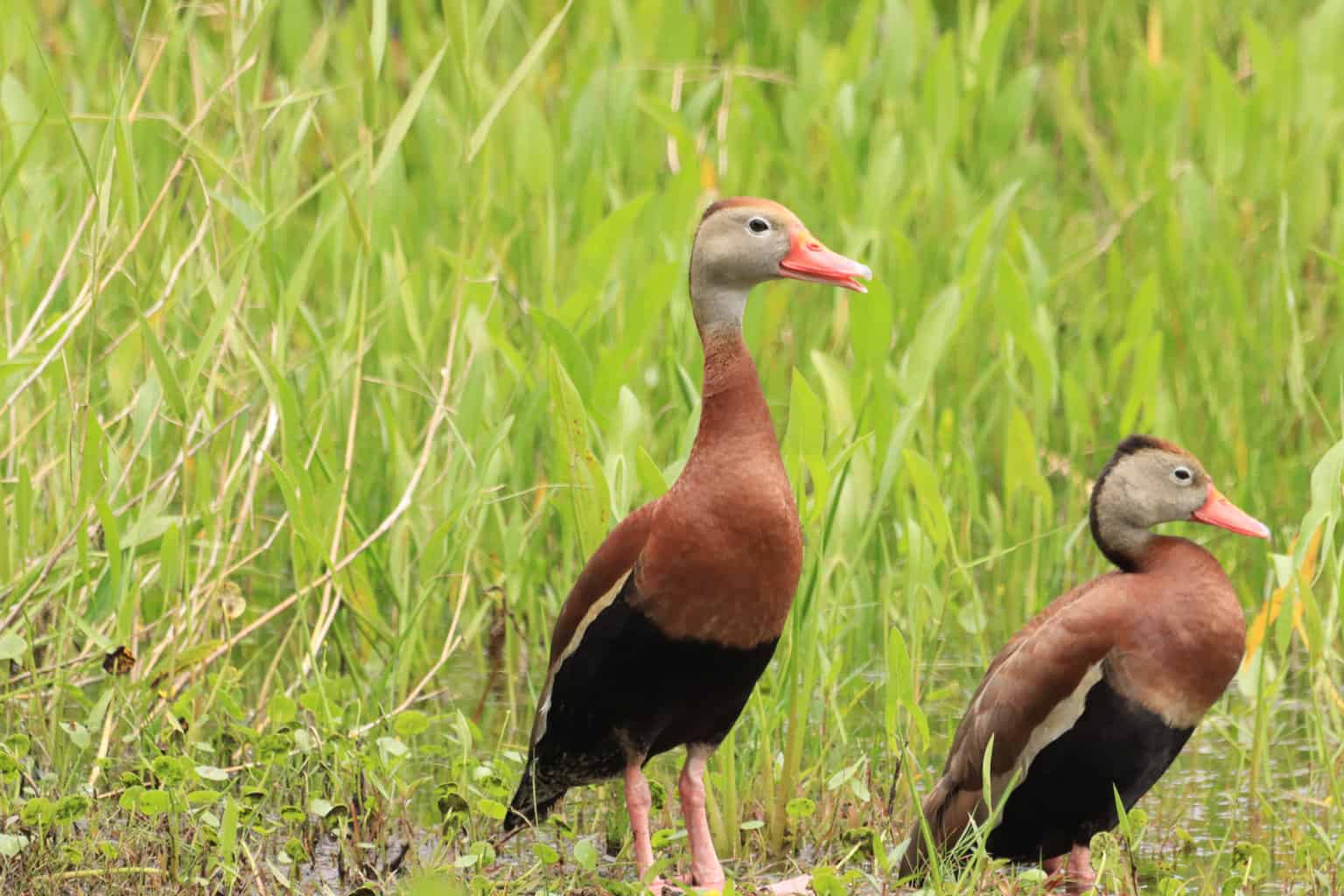
- Scientific Name: Dendrocygna autumnalis
- Length: 18 – 21 in
- Weight: Up to 28.8 oz
- Wingspan: 34 – 36 in
The Black-bellied Whistling Duck is one of the few species of duck that you’re more likely to see in Arizona during the summer than in winter.
This southerly duck species likes to spend most of its time in the warmer climates of South and Central America, and only ventures as far north as a few of the southernmost states of the US.
A very graceful-looking and recognizable duck species, the Black-bellied Whistling Duck could have just as easily been called the ‘Pink-beaked duck’ or the ‘Cinnamon-chested Duck’, but the distinctive black belly can indeed be seen both when this duck is on the water and when in flight.
The Black-bellied Whistling Duck is one of the few duck species where adult males and females look almost identical.
Perhaps it’s because their courtship is a bit different from most duck species – this is one of the few monogamous ducks, and will sometimes stay faithful to their partner for several years!
Mallard
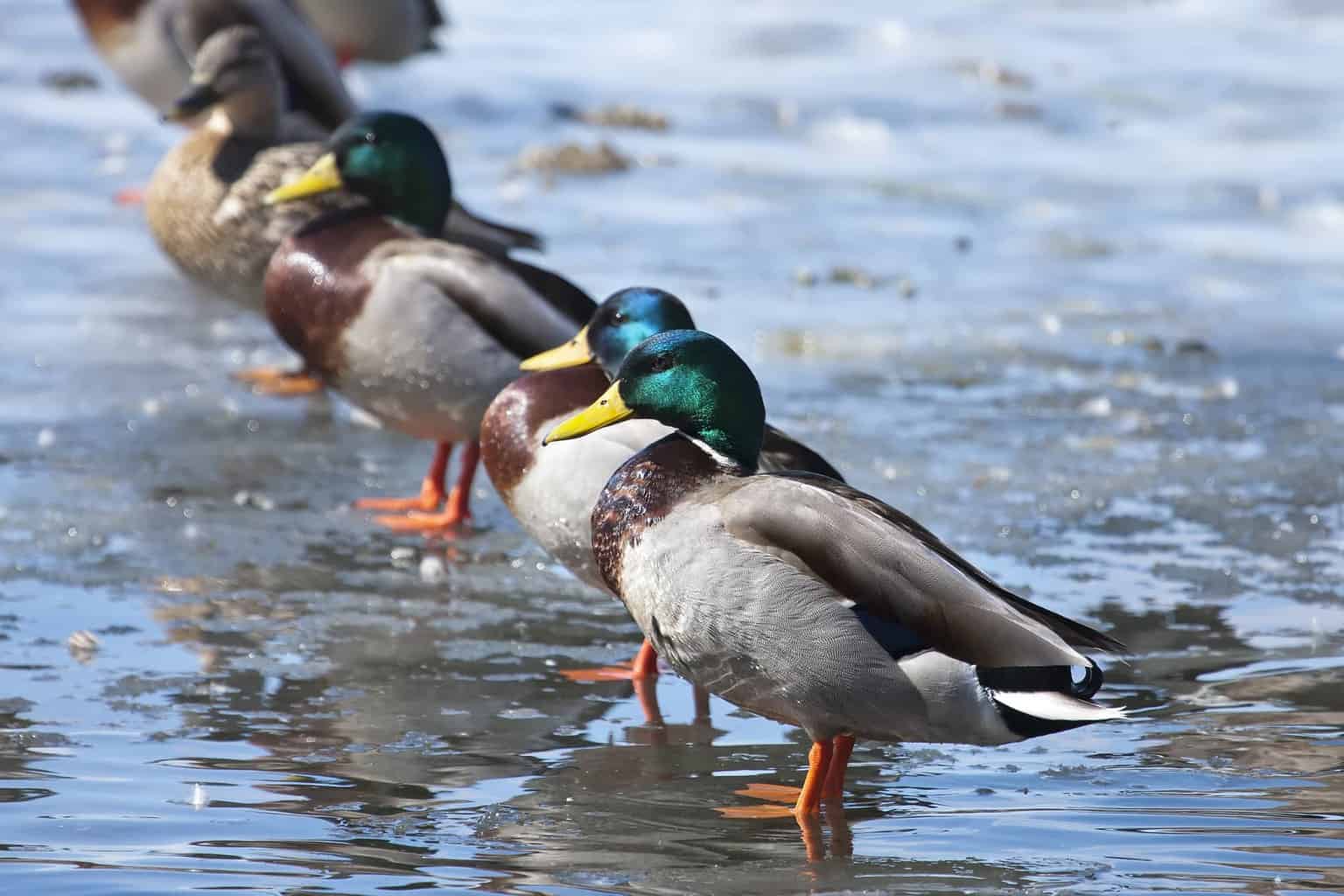
- Scientific Name: Anas platyrhynchos
- Length: 19.7 – 25.6 in
- Weight: 35 – 45 oz
- Wingspan: 32.3 – 37.4 in
It’s hardly surprising that mallards are the most common duck species in Arizona since they’re also the most numerous duck in America.
Mallards can be found year-round in all parts of Arizona, except for the very South-west of the state, where they only reside in winter.
If you’re walking near ponds or around the edges of lakes during the spring, be careful where you’re putting your feet. Mallards are masters of disguising their nests among the long grass, and the mottled brown of the female’s back is very difficult to spot as she sits motionless upon her eggs.
Interestingly, Arizona is also one of the few states that’s home to the Mexican variant of the mallard, the male of which looks almost identical to the female – lacking the classic green head completely!
Cinnamon Teal
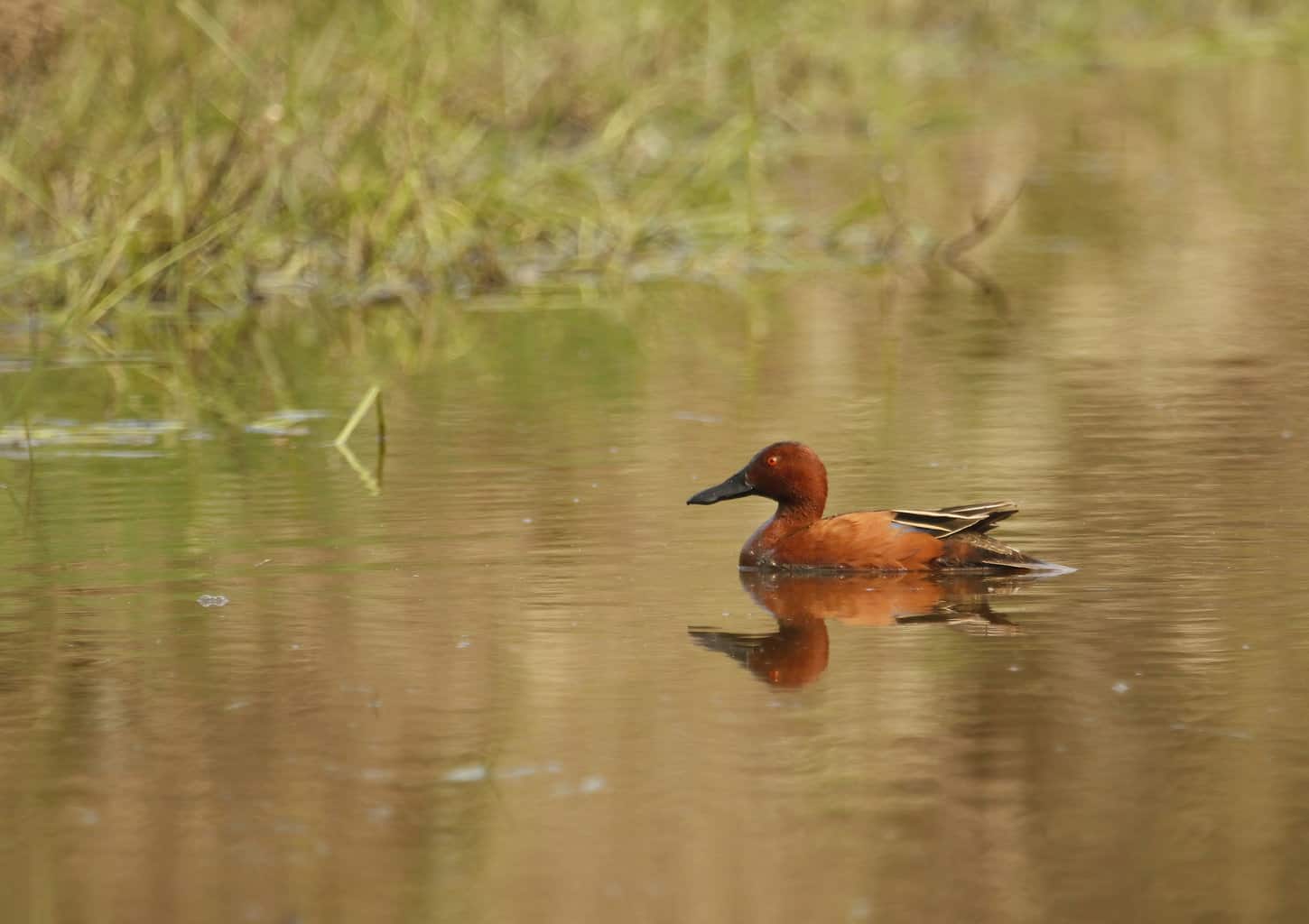
- Spatula cyanoptera
- Length: 14- 17 in
- Weight: Up to 16.4 oz
- Wingspan: 24 – 30 in
Cinnamon Teals are present year-round in Arizona, but you’re twice as likely to see them in the colder months than in the summer when some of the migratory flocks return for the mild winter climate.
It’s during the courtship season, from October-June, that Cinnamon Teals live up to their name. The breeding male has a gorgeous cinnamon color right across his upper body, complemented by strikingly red eyes.
These dabbling ducks prefer spending time in shallow water habitats and can be found in wetlands and marshy ponds, skimming the surface water for seeds, plants, and aquatic insects.
Sadly, Cinnamon Teals have been declining over the past 50 years due to the loss of the wetland habitats that they rely upon. Such decimations of wild bird populations are one of the signs that agricultural policies need to accommodate wildlife too.
Redheads
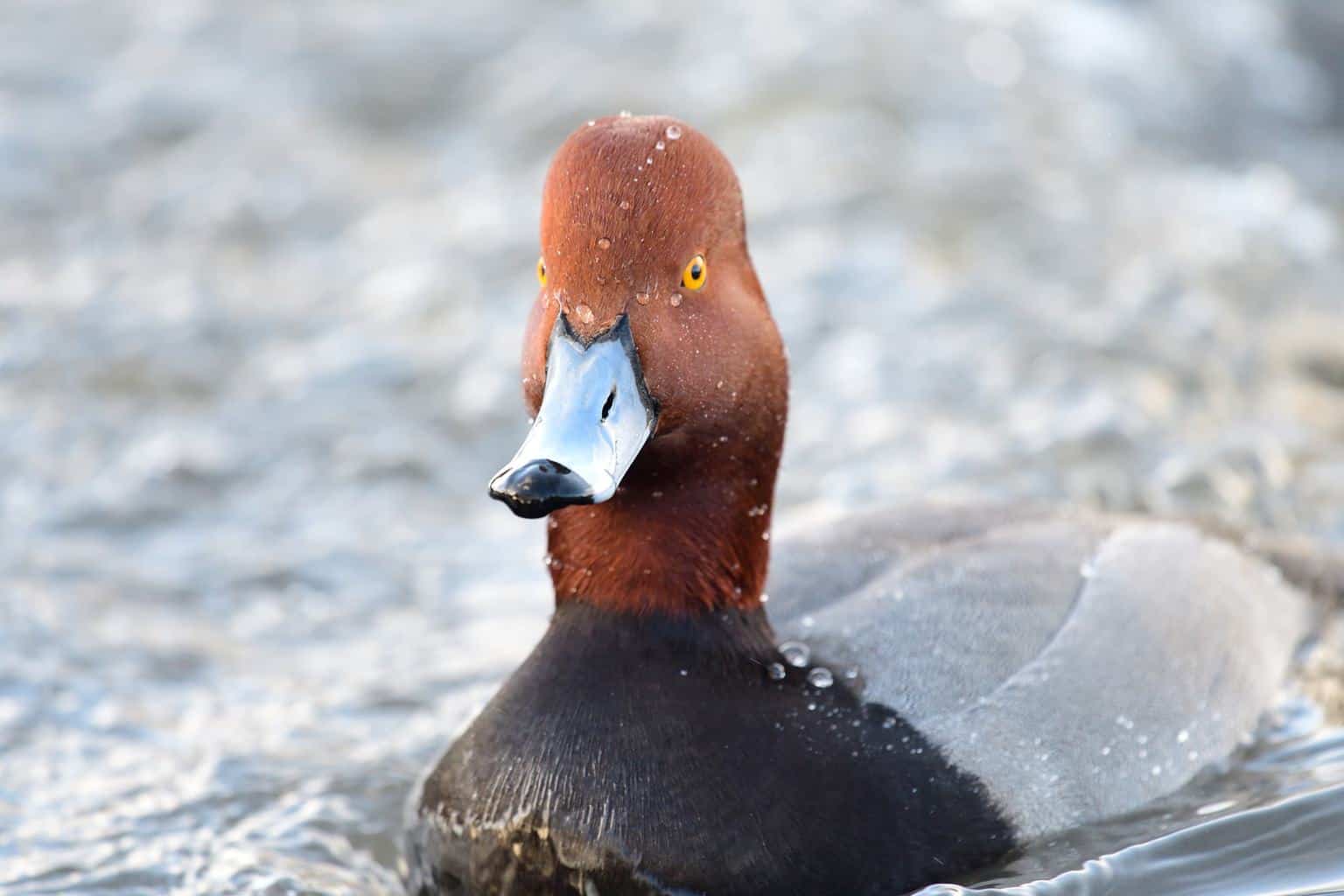
- Scientific Name: Aythya americana
- Length: 18-22 inches
- Weight: 32-40 oz
- Wingspan: 33 inches
Redheads are not a common sight in Arizona during the hot summers when only 1% of birdwatchers report spotting them.
In winter, however, huge flocks containing thousands of birds return to the state to congregate in large lakes where they can be seen mixing with other duck species. These large flocks are an easy target for hunters, which has made Redheads a popular game bird.
The male retains his cinnamon redhead all year round but sheds his light gray plumage on his back for browner feathers in the winter.
Wood Duck
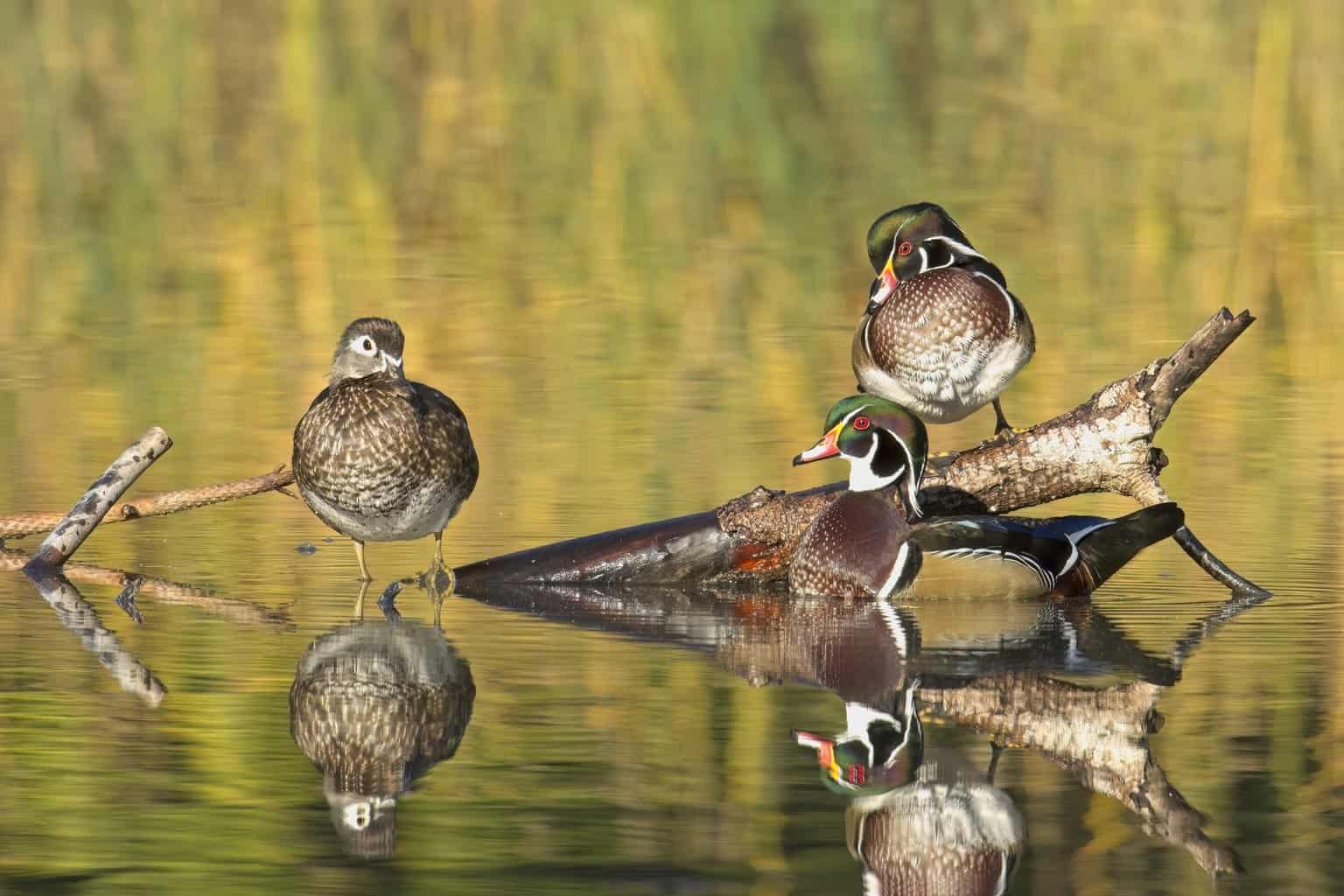
- Scientific Name: Aix sponsa
- Length: 18.5 – 21.3 in
- Weight: 16.0 – 30.4 oz
- Wingspan: 26.0 – 28.7 in
The comical-looking Wood Duck is a charming character, and one of the most beloved waterfowl of birding enthusiasts for its gorgeous colors and outlandish behavior.
Wood Ducks like to nest in tree cavities up to 50 feet high, from where their newly hatched chicks have to begin their lives with an almighty leap of faith! But they are also a kind of cuckoo among ducks in that they like to lay their eggs in our Wood Duck nests for them to raise!
Wood Ducks are more common in Arizona over the winter, but can occasionally be found year-round, particularly around Granite Creek and parts of the Verde Valley.
Green-winged Teal
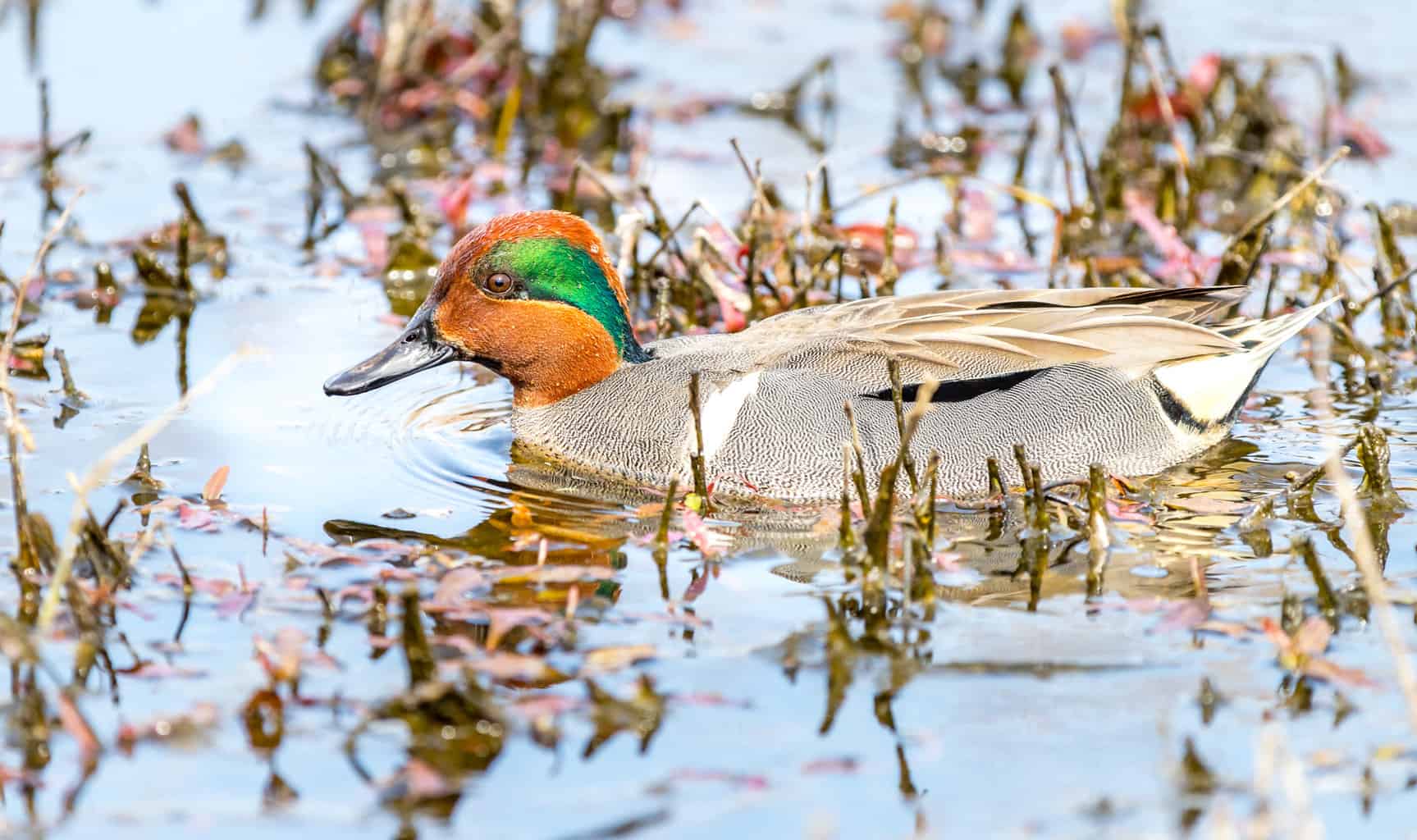
- Scientific Name: Anas carolinensis
- Length: 12.2-15.3 inches
- Weight: 4.9-17.6 ounces
- Wingspan: 20.5-23.2 inches
Normally weighing in at less than a pound, Green-winged Teals are the smallest of all duck species in North America,
But what they lack in size, they make up for in appearance. Male green-winged teals are a gorgeous sight between October and June when they take on a deep cinnamon-red head with an iridescent green mask.
The Green-winged Teal is almost exclusively a winter migrant in Arizona, but a few pairs can be found nesting towards the north of the state, near the border with New Mexico.
American Wigeon

- Scientific Name: Mareca americana
- Length: 16.5 – 23.2 in
- Weight: 19.1 – 46.9 oz
- Wingspan: 33.1 in
This cute-looking dabbling duck species is sometimes also known as ‘Baldpate’ because of the cream cap present in males during the breeding season.
Although American Wigeons are mostly just winter visitors in Arizona, some small populations stick around to breed in the northeastern part of the state too.
Often easier to hear than spot, male American Wigeons have a distinctive airy whistle that consists of two or three syllables – ‘Wiwhew’ or ‘wi-Weew-weew’.
Gadwall
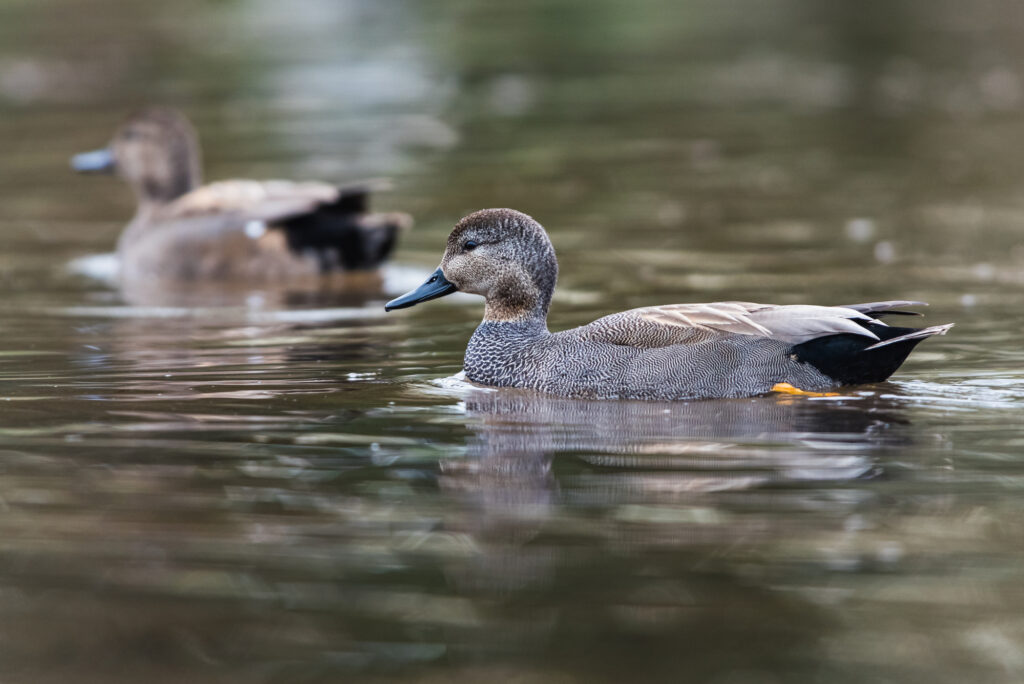
- Scientific Name: Mareca strepera
- Length: 18.1-22.4 inches
- Weight: 17.6-44.1 ounces
- Wingspan: 33.1 inches
Usually weighing around 2lb, Gadwalls are large dabbling ducks that can be frustratingly hard to identify. Non-breeding males and females look fairly similar, with light brown–gray mottled feathers, which the male shifts to a slightly deeper speckled gray during the breeding season.
Gadwalls are so closely related to mallards that the two species can breed together, producing a curious hybrid that has plumage appearing somewhere between the two species.
Gadwalls are usually only seen in Arizona during the winter, but small groups of them can also be found breeding in the northeastern part of the state.
Common Merganser
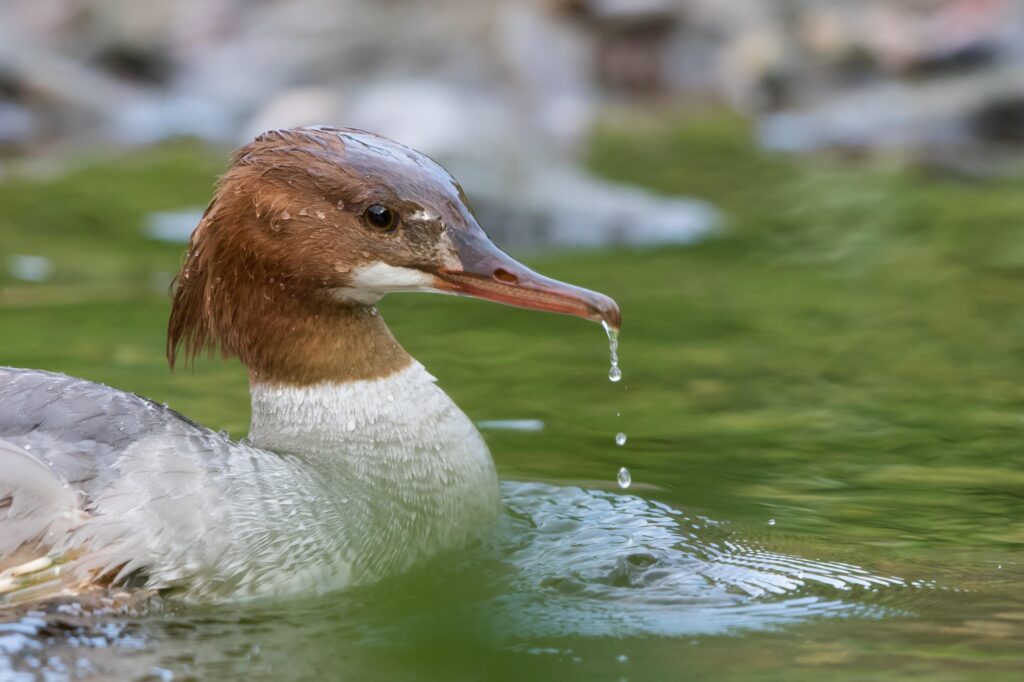
- Scientifc Name: Mergus merganser
- Length: 22 – 27 in
- Weight: 59 – 60.8 oz
- Wingspan: 31 – 37 in
Common Mergansers are the largest Merganser in the United States, with a long red bill that is a lethal instrument for catching fish.
Since you’re much more likely to see Common Mergansers during the winter in Arizona, you’ll be lucky enough to see the males in their beautiful breeding plumage – a slick, deep green head and bright white body.
Surprisingly, a few Common Mergansers do stay for the summer in Arizona, along a confined strip in the mid-eastern part of the state. Unfussy in their breeding habits, they seem happy to nest both in tree cavities or nest boxes and on the ground near large lakes.
Ducks Present In Arizona Only During Winter
Northern Shoveler
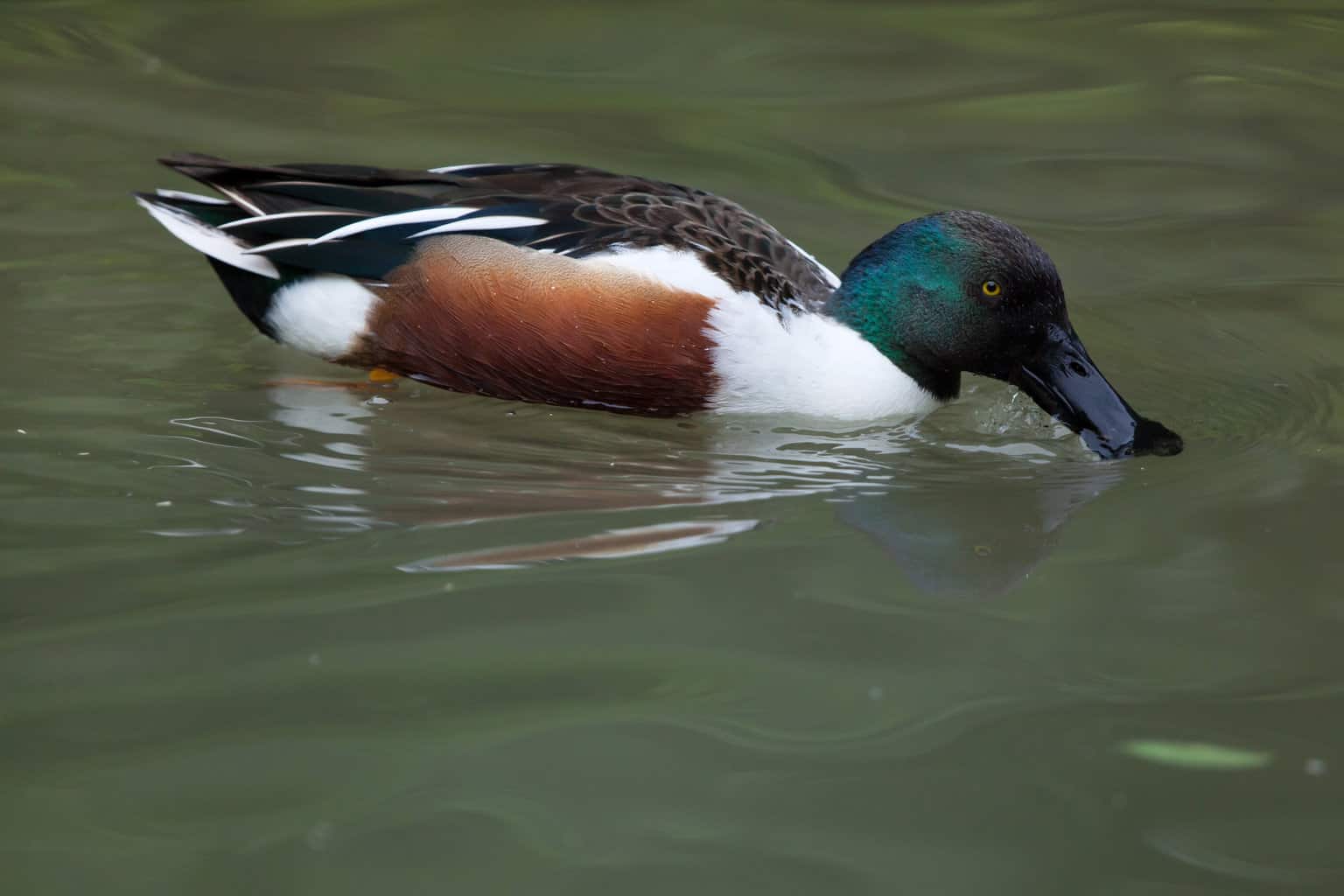
- Scientific Name: Spatula clypeata
- Length: 17.3 – 20.1 in
- Weight: 14.1 – 28.9 oz
- Wingspan: 27.2 – 33.1 in
Northern Shovelers are handsome ducks that are most easily distinguished by their enormous bill which they uses to sieve the water’s surface for plankton and seeds.
The male has a beautiful, iridescent green head in the breeding season that’s reminiscent of a mallard. This undergoes a remarkable transformation through the year, however, turning from completely gray in May until August, to its full splendor from December until May.
Since the Northern Shoveler is most prevalent in Arizona during the winter months, you’re likely to see them at their brilliant best, as the males prepare early to win the charms of the females!
Northern Pintail
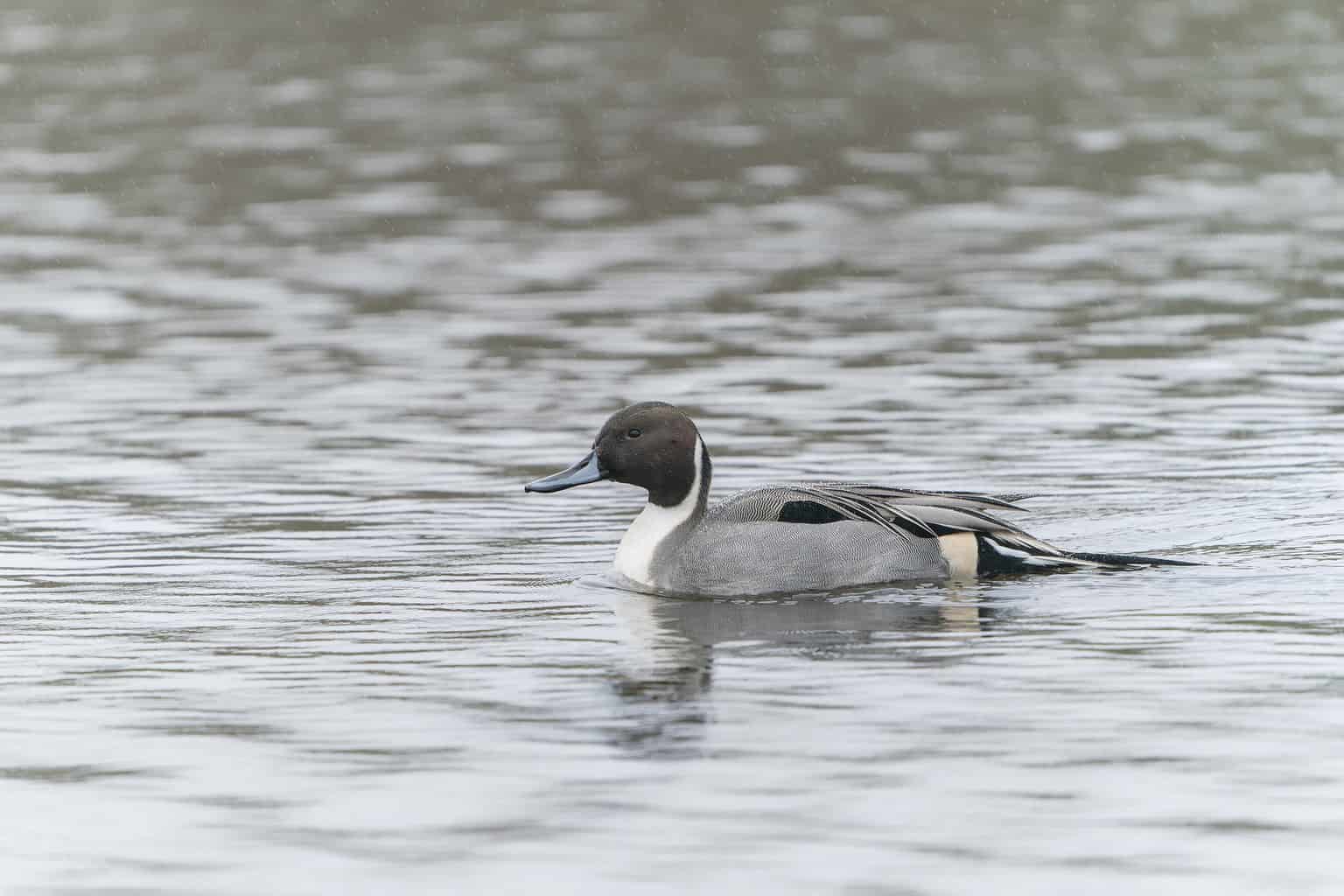
- Scientific Name: Anas acuta
- Length: 20-30 inches
- Weight: 16-48oz
- Wingspan: 20-30 inches
The slender Northern Pintail is only a winter visitor in Arizona when large numbers of them arrive in the state between breeding seasons. They are most easily identified by their long tail, from which their name is derived.
Built to fly long distances, the Northern Pintail breeds right up into the Northern reaches of Alaska during the summer but prefers the warmth of the southern states over winter.
Amazingly, Northern Pintails are related closely enough to mallards that the two species can breed together, producing a very attractive hybrid that can have the bright colors of a mallard combined with the elegant shape and long tail of a pintail!
Ruddy Duck
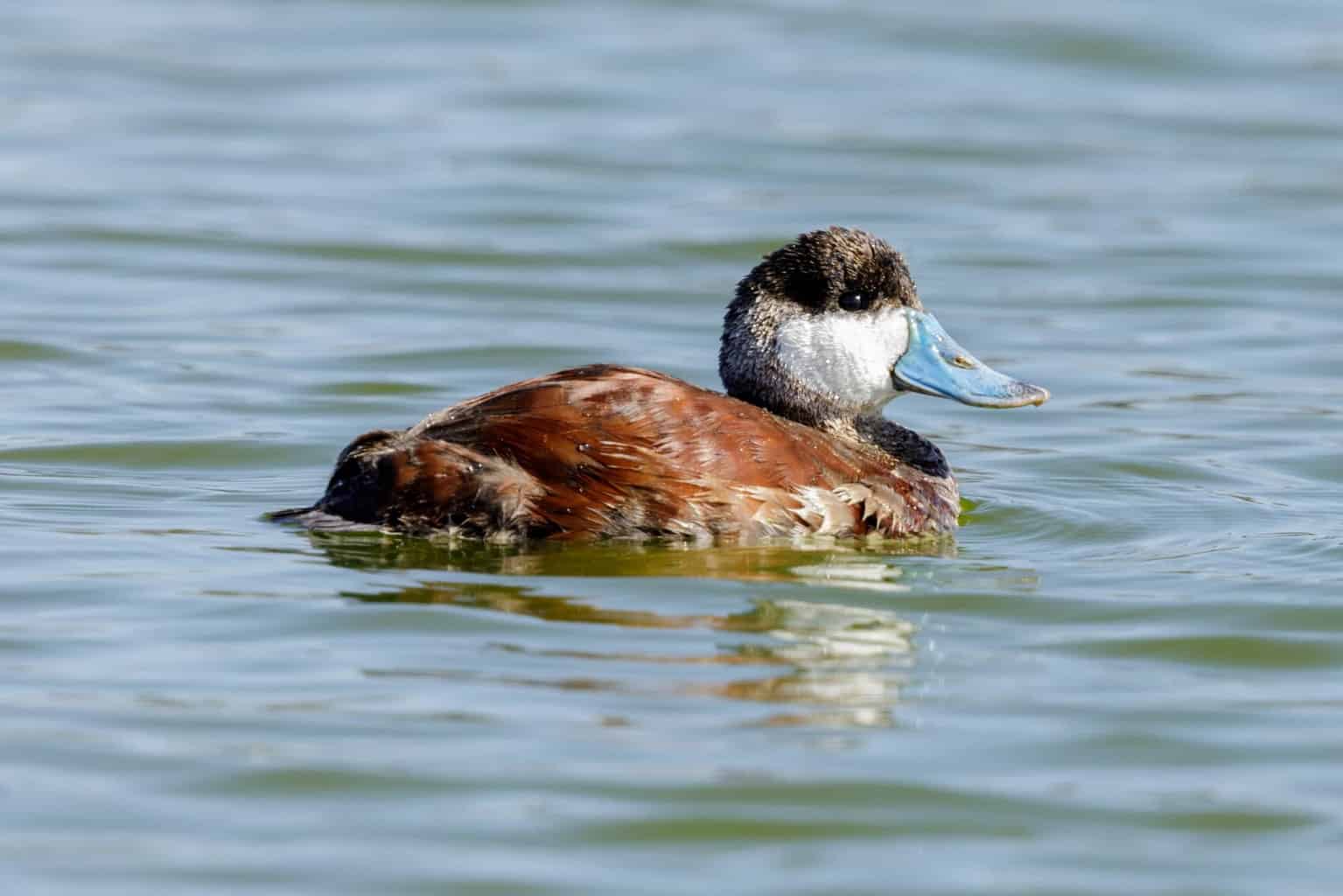
- Scientific Name: Oxyura jamaicensis
- Length: 13.5-17 inches
- Weight: 14.5-20.2 oz
- Wingspan: 18.5 inches
The Latin name ‘jamaicensis’ literally means ‘from Jamaica’, and this gives us a clue to the preferred climate of the Ruddy Duck. Although their breeding grounds extend well into Canada, the Ruddy Duck prefers to overwinter in warmer southern states like Arizona.
Because they’re only a winter migrant, you’re unlikely to see Ruddy Ducks in their intriguing breeding plumage, (which they only don from March-August).
In winter the male’s bills are gray rather than the bright blue bills they sport at other times of the year, but they can still be recognized by their dark black head cap and white cheeks.
Ruddy Ducks prefer open water, where they stick together in tight flocks, sometimes mixing with groups of other diving duck species.
Ring-necked Duck
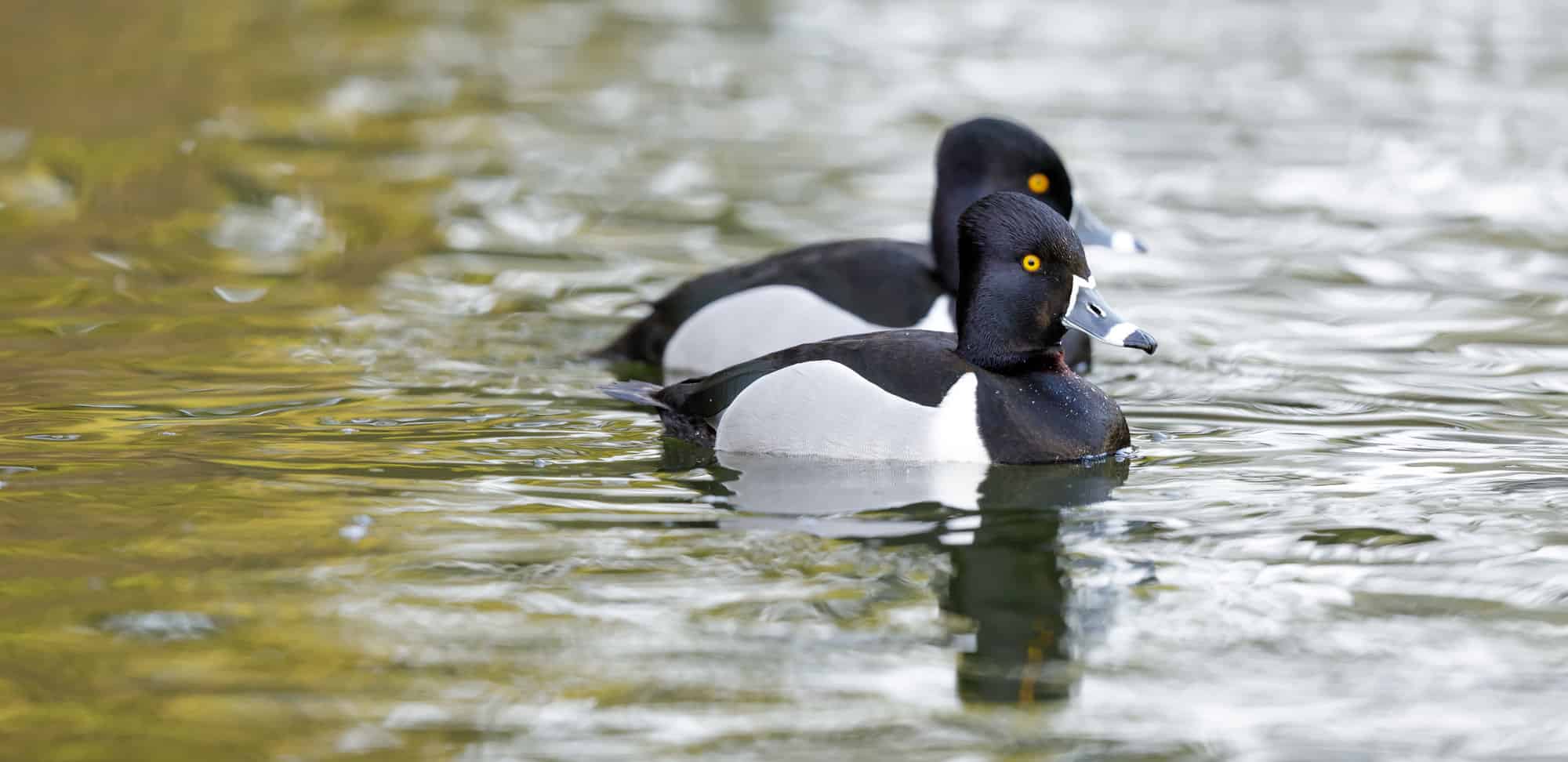
- Scientific Name: Aythya collaris
- Length: 14 – 18 in
- Weight: Up to 32.09 oz
- Wingspan: 24 – 30 in
Ring-necked Ducks prefer the northerly wilderness of Canada and the very northernmost parts of the United States to raise their young, but in winter huge flocks of them descend on Arizona as a winter refuge.
‘Ring-necked’ is not such a good identifying term for this medium-sized duck, which only has a very subtle pale brown ring that’s hard to spot from a distance. More obvious is the white band that runs around near the tip of the beak in both sexes.
Ring-necked Ducks prefer to feed in shallow ponds and rivers, often nearby trees, rather than the open expanses of water enjoyed by most diving duck species.
Bufflehead
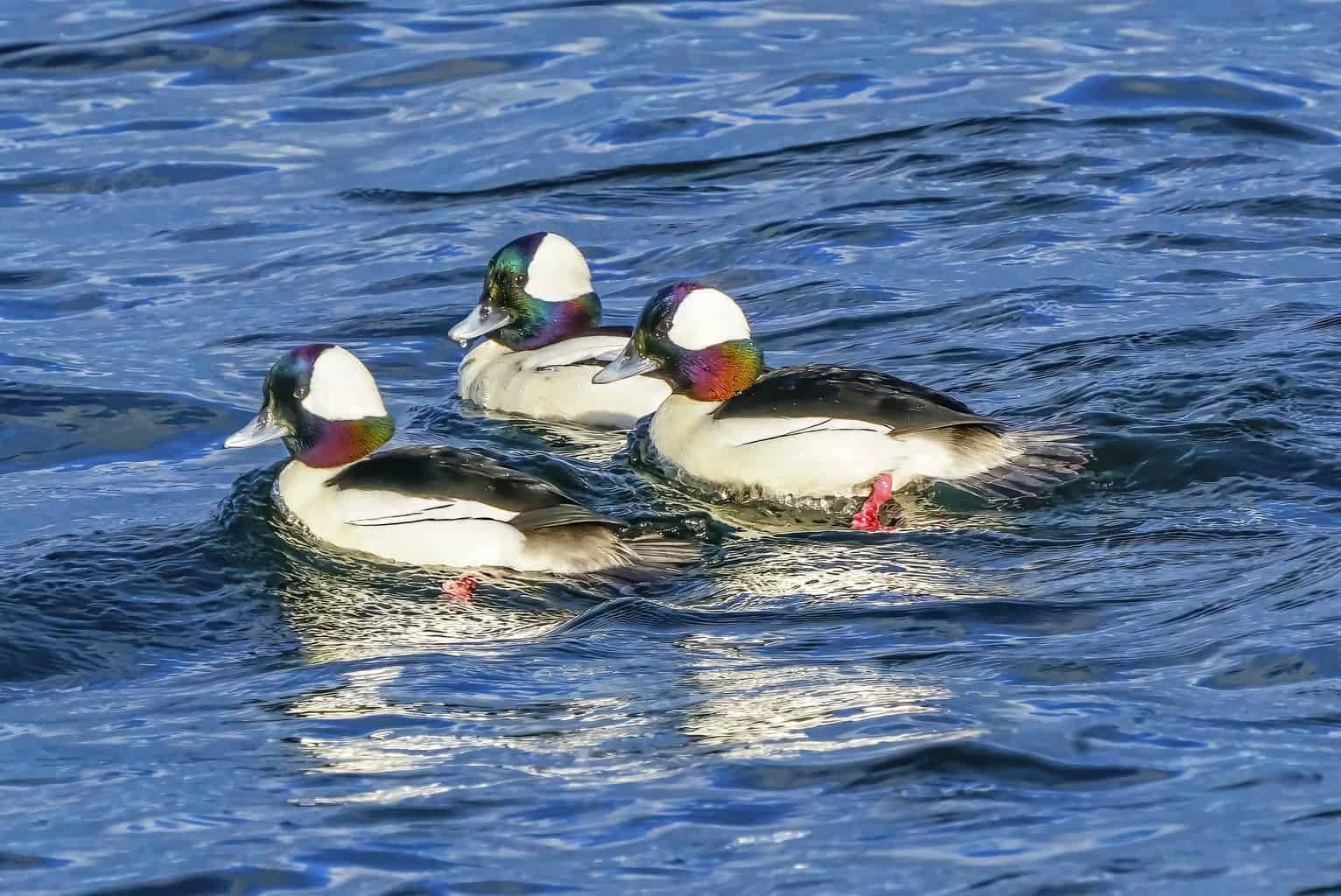
- Scientific Name: Bucephala albeola
- Length: 13-16 inches
- Weight: 11.5-16 oz
- Wingspan: 22 inches
The Bufflehead is a compact duck with a head that might appear disproportionally large for its body.
Between October and May, male Buffleheads have beautiful dark iridescent feathers on their faces, contrasting the white back of the head, so you’re sure to see these birds at their best during their winter stopovers in Arizona.
This diving duck is notable for its very fast wing beats in flight and likes to feed on mollusks, crustaceans, and insect larvae.
Lesser Scaup
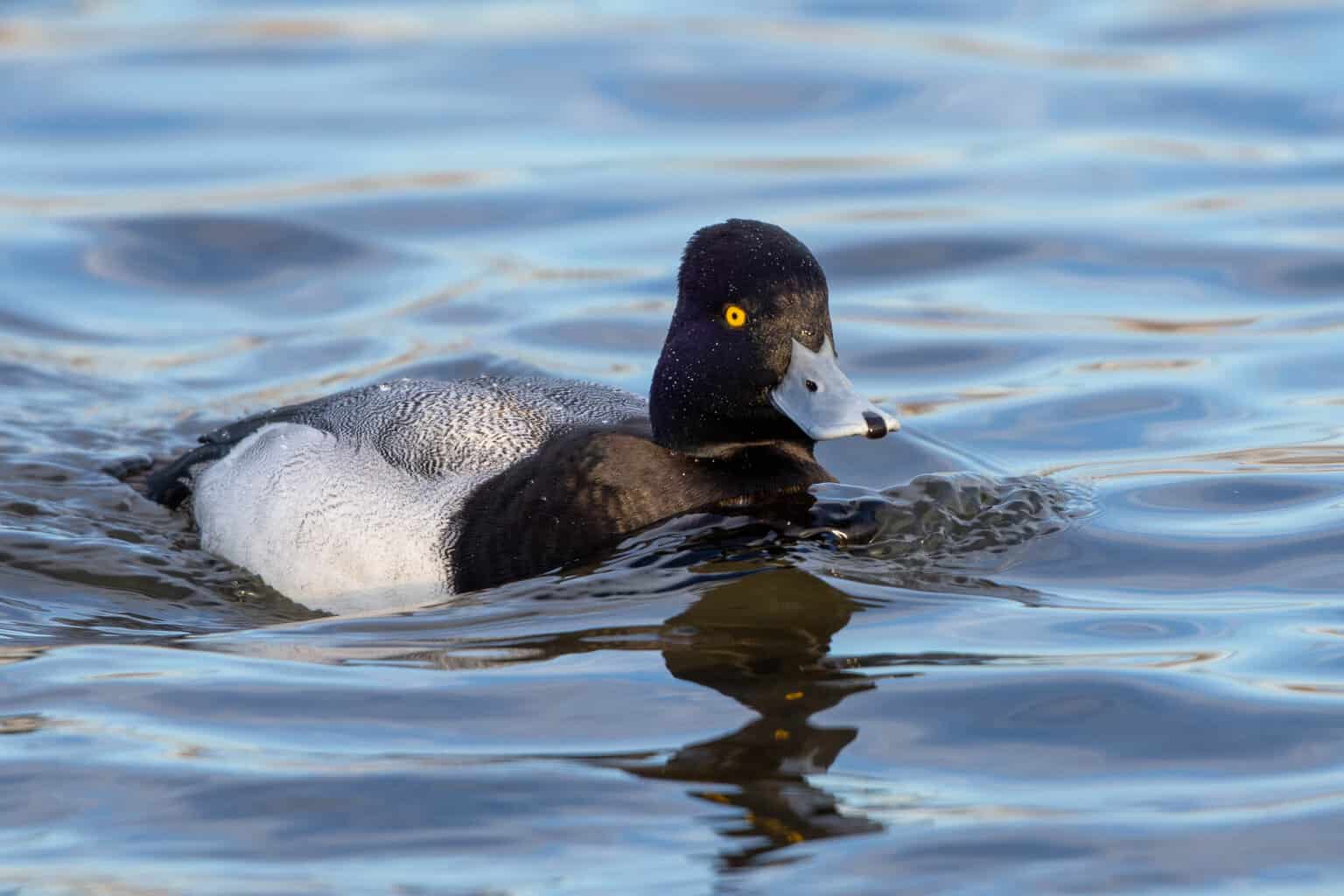
- Scientific Name: Aythya affinis
- Length: 15.3 – 18.1 inches
- Weight: 16 – 38.4 oz
- Wingspan: 26.8 – 30.7 inches
Lesser Scaups are difficult to distinguish from their only-slightly larger cousins the Greater Scaup, but luckily, in most of Arizona, you’re unlikely to have that problem.
Whereas Lesser Scaups occupy the entire state during the winter season, Greater Scaups are very rare in Arizona except in the very north-western-most corner of the state where there are some larger populations.
Lesser Scaups are more fond of freshwater than their relatives and can be found on ponds and lakes across the state during the winter months, when the males have attractive, contrasting black and white plumage.
Canvasback
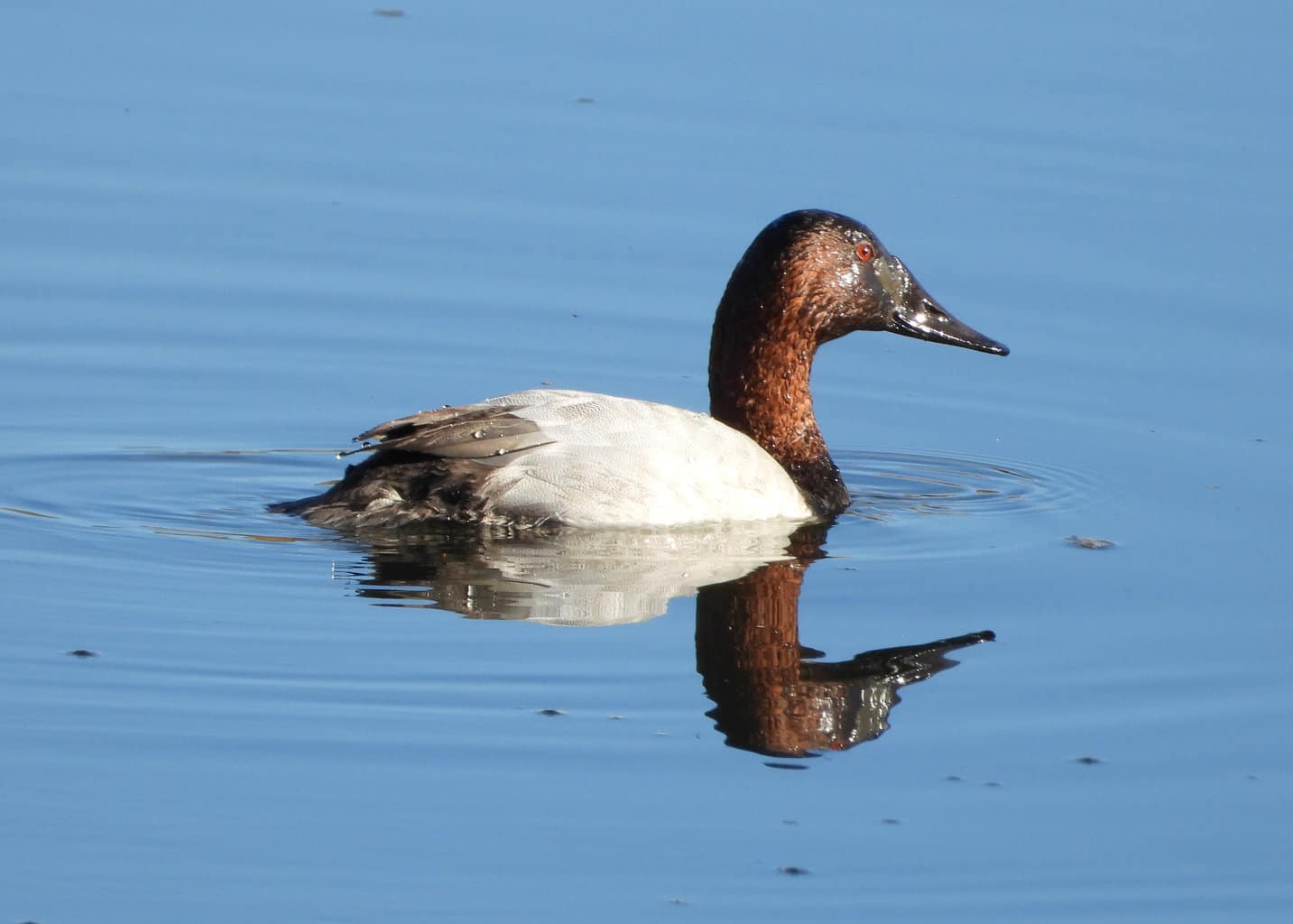
- Scientific name: Aythya valisineria
- Length: 19 – 24 in
- Weight: Up to 58.48 oz
- Wingspan: 28 – 36 in
Canvasbacks are so-called because of their canvas gray-white backs. Also distinctive among male birds are the deep cinnamon red head and scarlet eyes.
Canvasbacks are water-loving to the point that you might wonder if they have a phobia of dry land! These ducks live, eat, sleep, and even nest on the water among aquatic vegetation!
These large, powerful diving ducks can dive up to 30 feet deep, looking for all kinds of animal and plant-based foods, and are particularly fond of (the sadly declining) wild celery.
Common Goldeneye
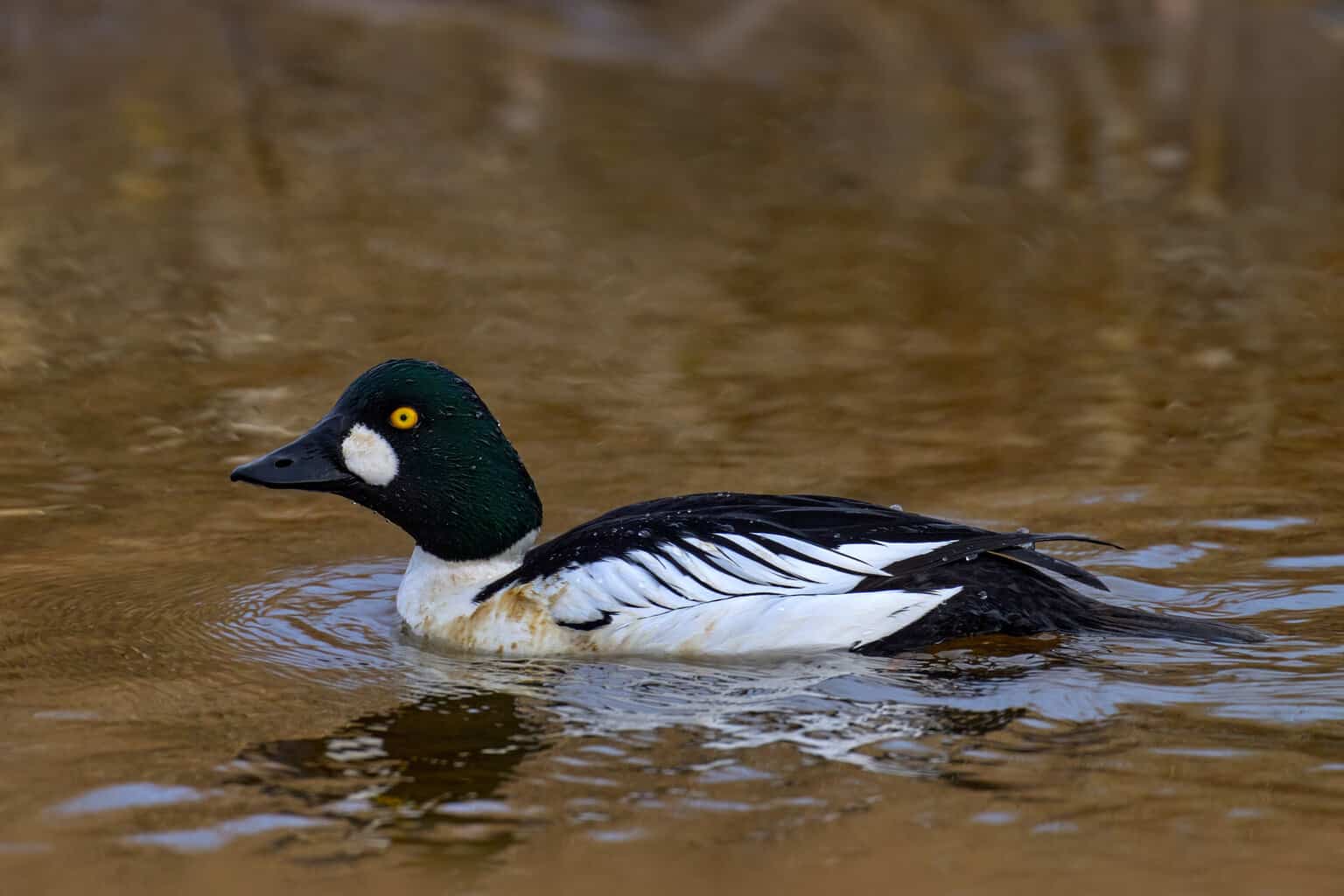
- Scientific Name: Bucephala Clangula
- Length: 16-20 inches
- Weight: 21-29.1 oz
- Wingspan: 30.3-32.7 inches
Common Goldeneyes can only be found breeding in the very northernmost states of America, and Canada, but in winter they can be spotted everywhere except the very south of Arizona.
Although they’re easy to confuse with Barrow’s Goldeneye, in Arizona there’s little room for mistakes since Barrow’s Goldeneye is a very rare visitor here.
From October to June, the male exhibits handsome breeding plumage consisting of a mostly-white body, dark back, and an enlarged white patch on the cheek against a dark head.
These expert diving ducks are fairly carnivorous and enjoy feeding on crustaceans, fish, insects, and mollusks.
Hooded Merganser
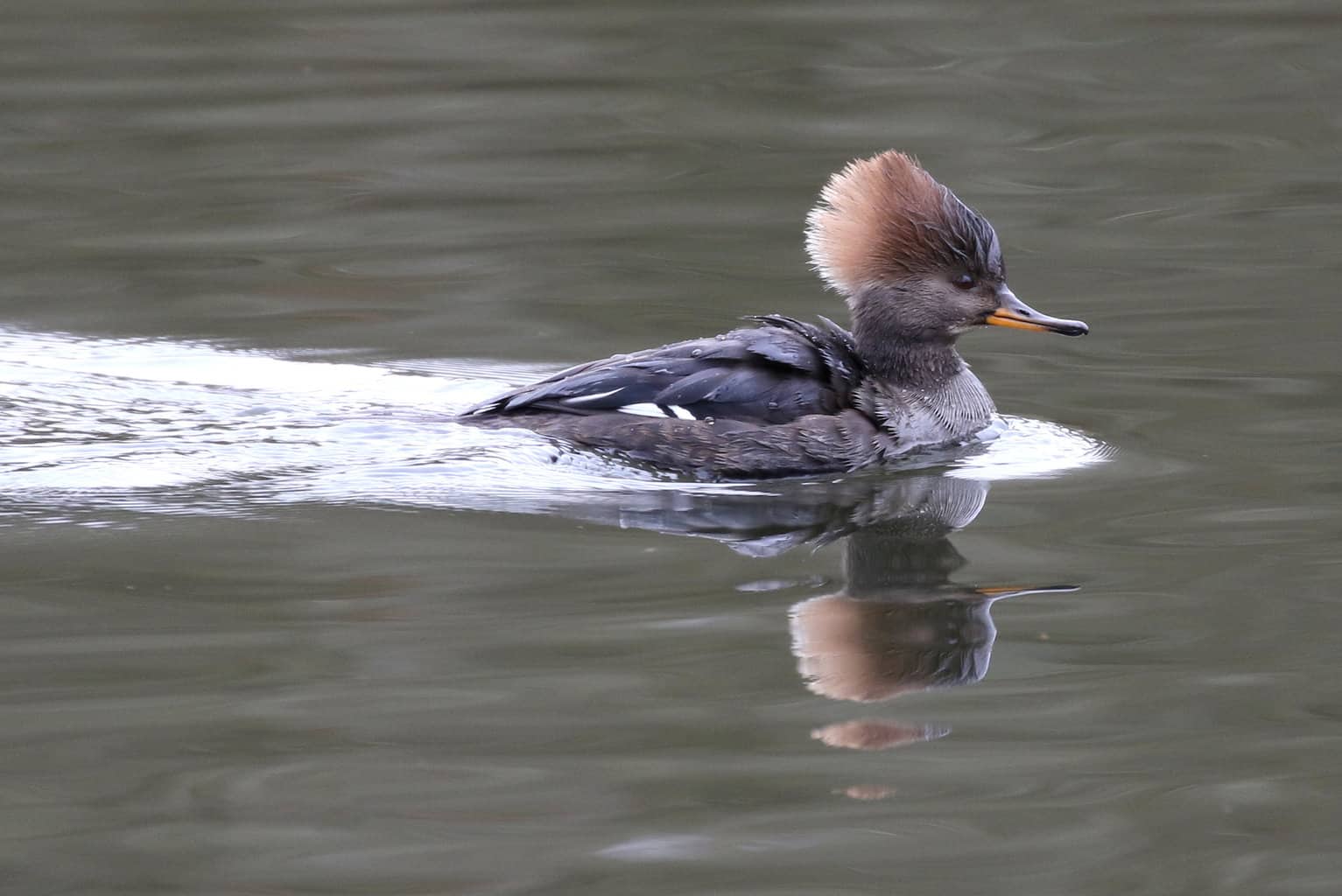
- Scientific Name: Lophodytes cucullatus
- Length: 15.8-19.3 inches
- Weight: 16-31 ounces
- Wingspan: 23.6-25 inches
Hooded Mergansers are fairly rare in Arizona but do occur in isolated pockets in the state during the winter season.
The males’ plumage from September – June is a real show stopper, with a bright white crest that, when erected, makes his head suddenly look twice the size.
Unlike many diving duck species, Hooded Mergansers prefer more sheltered bodies of water such as wooded ponds, swamps, and tidal creeks than large inland lakes and reservoirs.
In flight, you may notice the wings of Hooded Merganser producing a high-frequency cricket-like trill. As for their voice, both males and female ducks make a variety of soft, purring, croaking sounds.
Red-breasted Mergansers
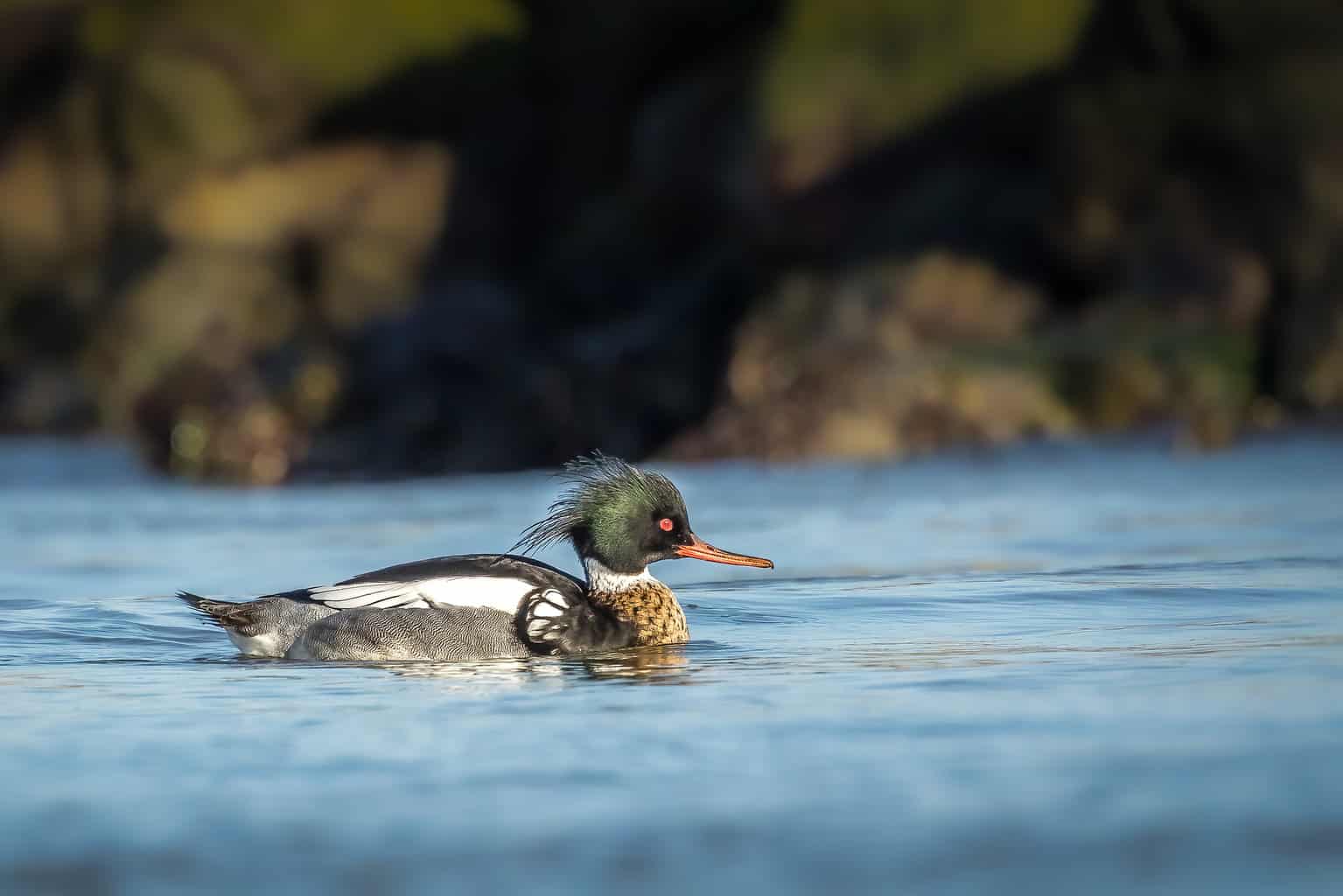
- Scientific Name: Mergus serrator
- Length: 20 – 24 inches
- Weight: 29 – 35 oz
- Wingspan: 28 – 34 inches
Red-breasted Mergansers are a very rare sight in Arizona. Since they normally over-winter along coastal areas, it’s unusual for them to venture so far inland, although you might occasionally see them in the westernmost part of the state.
A handsome bird, Red-breasted Mergansers have lovely red eyes and bills, along with tufts at the back of their head that are present in both males and females.
These diving ducks are skillful hunters and feed mainly on small fish in shallow waters, occasionally in a group.
White-winged Scoter
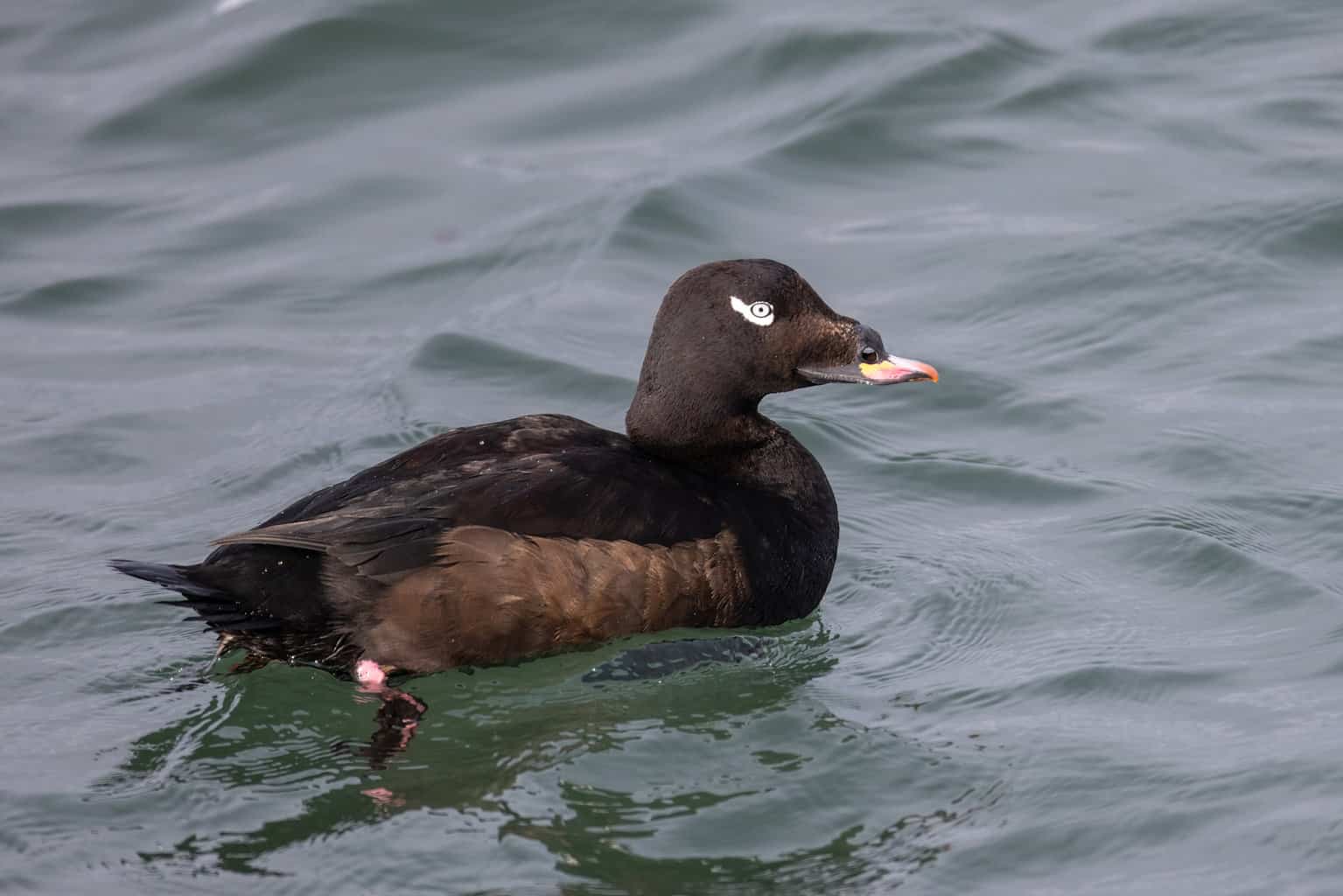
- Scientific Name: Melanitta deglandi
- Length: 19 – 24 in
- Weight: Up to 62.4 oz
- Wingspan: 33 – 41 in
If you see a huge, dark duck, flying past with white patches on its upper and under wings, you may just have spotted one of the rarest ducks in Arizona – the White-winged Scoter.
These enormous birds might remind you more of a small goose than a duck! Strong flyers, these adventurous migratory ducks have been known to drift across the Atlantic, sometimes ending up in Iceland and UK!
Because of their tendency to explore, White-winged Scoters can occasionally be seen passing through Arizona, although they spend most of their time out by the coast in the winter, migrating to Canada and Alaska for breeding.
Their smaller cousins, the Black Scoter and Surf Scoter may also be seen in the state on very rare occasions.
Blue-winged Teal
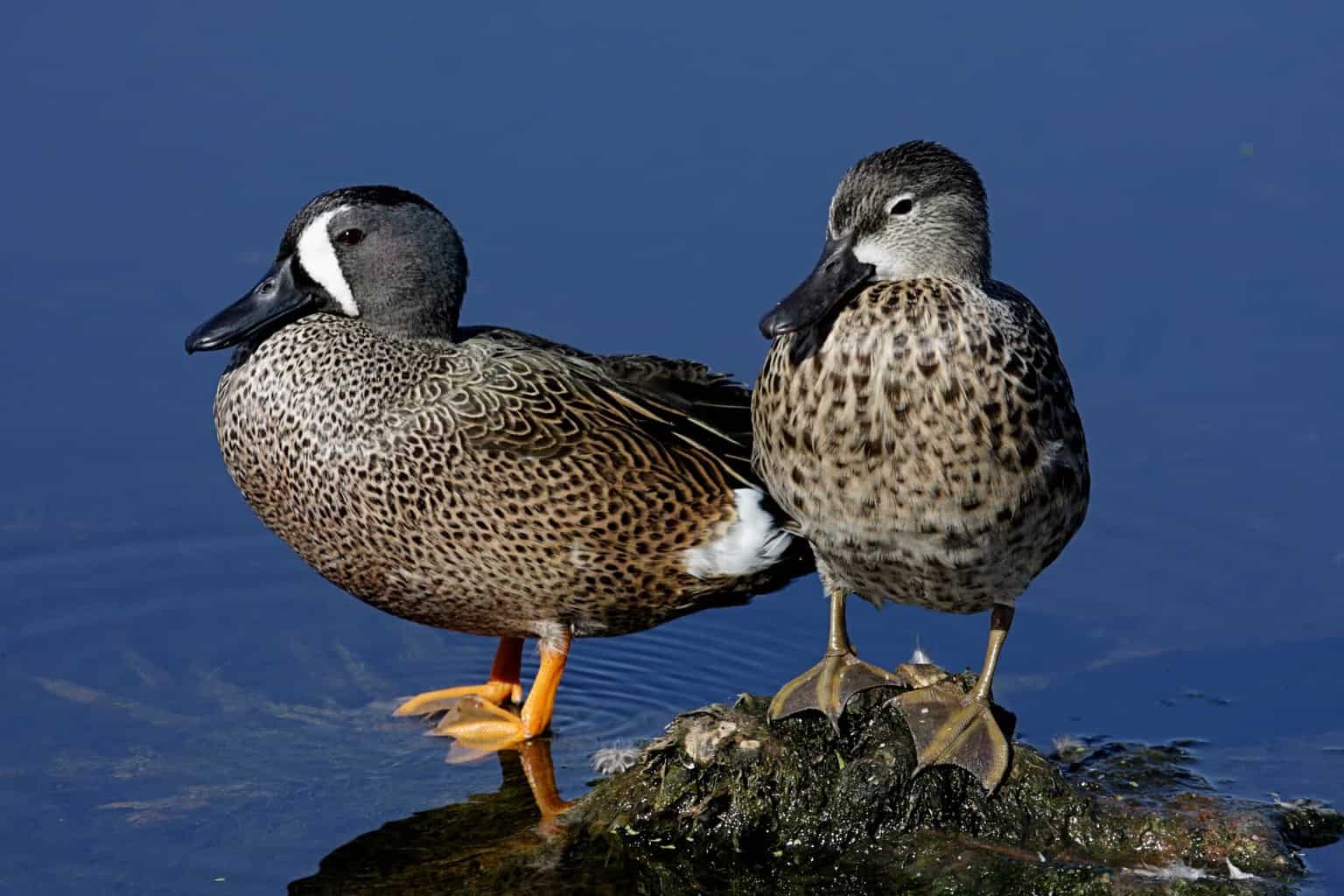
- Scientific Name: Spatula discors
- Length: 15 – 17 in
- Weight: Up to 19.18 oz
- Wingspan: 23 -31 in
Blue-winged Teals are purely migratory passengers in most of Arizona, but they make our list because small colonies of them sometimes settle in the southwest of the state during the winter.
The best place to see them is in shallow, muddy water, where they swim with their bill outstretched, skimming seeds and plant material from the water’s surface.
While their colors appear fairly muted, the tops of their wings have lovely blue and iridescent green feathers that can be seen when the birds are taking off or landing.
Conclusion
Arizona is a seasonal home for a surprising number of duck species. While less than half of them choose to stick around for the scorching summers, the mild winters provide a sunny sanctuary for all manner of ducks retreating from colder weather further north.
The ducks listed here make up only a tiny part of the incredible 563 bird species in Arizona – a truly amazing state for bird watching!
With so much diversity out there, be sure to read our guide to 31 of the most stunning birds in Arizona here.

